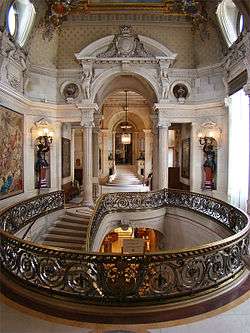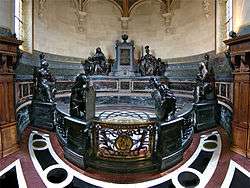Château de Chantilly
| Château de Chantilly | |
|---|---|
 The north-west façade | |
| General information | |
| Type | Château |
| Architectural style | Renaissance |
| Town or city | Chantilly |
| Country | France |
| Construction started | 1358 |
| Completed | 1882 |
| Design and construction | |
| Architect | Jean Bullant, Honoré Daumet |
The Château de Chantilly (pronounced: [ʃɑ.to də ʃɑ̃.ti.ji]) is a historic château located in the town of Chantilly, France.
The site comprises two attached buildings: the Petit Château built around 1560 for Anne de Montmorency, and the Grand Château, which was destroyed during the French Revolution and rebuilt in the 1870s.
Owned by the Institut de France, the château houses the Musée Condé. It is one of the finest art galleries in France and is open to the public.
History

The estate's connection with the Montmorency family began in 1484. The first mansion (no longer in existence, now replaced by the Grand Château) was built in 1528–1531 for the Constable Anne de Montmorency by Pierre Chambiges. The Petit Château was also built for him, around 1560, probably by Jean Bullant. In 1632, after the death of Henri II, it passed to the Grand Condé who inherited it through his mother, Charlotte Marguerite de Montmorency.
Several interesting pieces of history are associated with the château during the 17th century. Molière's play, Les Précieuses ridicules, received its first performance here in 1659. Madame de Sévigné relates in her memoirs that when Louis XIV visited in 1671, François Vatel, the maître d'hôtel to the Grand Condé, committed suicide when he feared the fish would be served late.
The original mansion was destroyed in the French Revolution. It was repaired in a modest way by the last Condé, but the entire property was confiscated from the Orléans family between the years 1853 and 1872, during which interval it was owned by Coutts, an English bank. Chantilly was entirely rebuilt in 1875–1882 by Henri d'Orléans, duc d'Aumale (1822–1897) to the designs of Honore Daumet. The new château met with mixed reviews. Boni de Castellane summed up one line of thought: "What is today styled a marvel is one of the saddest specimens of the architecture of our era — one enters at the second floor and descends to the salons". In the end, the Duc d'Aumale bequeathed the property to the Institut de France upon his death in 1897.
Musée Condé


The château's art gallery, the Musée Condé, houses one of the finest collections of paintings in France (after the Louvre). It specializes in French paintings and book illuminations of the 15th and 16th centuries.
Works in the art gallery (many of them are in the Tribune Room) include Sassetta's Mystic Marriage of St. Francis, Botticelli's Autumn, Piero di Cosimo's Portrait of Simonetta Vespucci, Raphael's Three Graces and Madonna of Loreto, Guercino's Pietà, Pierre Mignard's Portrait of Molière as well as four of Antoine Watteau's paintings and Jean-Baptiste-Camille Corot's Le concert champêtre. Other paintings in the collection include works by Fra Angelico, Filippino Lippi, Hans Memling, 260 paintings and drawings by François and Jean Clouet, Veronese, Barocci, Annibale Carracci, Domenichino, Salvator Rosa, Nicolas Poussin, Philippe de Champaigne, Van Dyck, Guido Reni, Jean-Baptiste Greuze, Joshua Reynolds, Eugène Delacroix, Ingres, Géricault.
The library of the Petit Château contains over 1500 manuscripts and 17,500 printed volumes, that is part of the collection of over 700 incunabula, and some 300 medieval manuscripts, including one page of the Registrum Gregorii (c. 983), the Les très riches heures du Duc de Berry, the Ingeborg Psalter and 40 miniatures from Jean Fouquet's Book of Hours of Etienne Chevalier.
Park and Chantilly racecourse
The main French formal garden, featuring extensive parterres and water features, was laid out principally by André Le Nôtre for the Grand Condé. The park also contains a French landscape garden with a cascade, pavilions, and a rustic ersatz village, the Hameau de Chantilly. The latter inspired the Hameau de la reine of Marie Antoinette in the Gardens of Versailles.
The estate overlooks the Chantilly Racecourse and the Grandes Écuries (Great Stables) which contains the Living Museum of the Horse. According to legend, Louis Henri, Duc de Bourbon, Prince of Condé believed that he would be reincarnated as a horse after his death. In 1719, he asked the architect, Jean Aubert to build stables suitable to his rank.
Restoration
The World Monuments Fund included the site in the 1998 World Monuments Watch to call attention to water infiltration and high humidity in the Galerie des Actions de Monsieur le Prince, and again in the 2002 World Monuments Watch due to the precarious condition of the entire estate.[1] Funding for restoration work was provided from various sources, including American Express and the Generali Group.[2] Subsequently, in response to an appeal for the restoration of the château, The Aga Khan donated €40m, accounting for more than half of a €70m needed by the Institut de France to complete the project.[3] In 2008 the World Monuments Fund completed the restoration of the Grande Singerie, a salon with paintings on the walls of monkeys engaged in human activities, once a fashionable salon motif, but with few examples surviving today.[4]
Modern uses
- The château and the Great Stables were featured in the 1985 James Bond movie A View to a Kill, as the home of villainous Max Zorin (played by Christopher Walken) which was being infiltrated by Bond (played for the last time by Roger Moore) in his quest to find out more about Zorin, who had already aroused suspicions of MI6 with various business activities, and ultimately eliminate him.[5]
- Pink Floyd performed, on two consecutive nights, at the château during their The Division Bell tour on July 30–31, 1994.
- Every two years, in June, the "Nuits de Feu" international fireworks competition is held in the château's garden.
- Ronaldo married model and MTV VJ Daniela Cicarelli in the château in 2005. The ceremony reportedly cost €700,000.
- Every May, a rowing regatta, the Trophee des Rois, is held in the grounds. French university crews compete in the 750m race for a trophy.
- David Gilmour, guitarist and singer of Pink Floyd performed at the venue on 16 July 2016 as part of his Rattle That Lock world tour.
- Battlefield 1 features a level that is based around the Château called "Ballroom Blitz".
See also
References
- ↑ World Monuments Fund - Château de Chantilly
- ↑ Le Figaro, "Les Batailles du Grand Condé", October 15, 2007. (French)
- ↑ Jon Henley, The Guardian, "Aga Khan gives £27m to Chantilly restoration", May 3, 2005.
- ↑ Wendy Moonan, New York Times, "Chateau’s Monkey Room Is Lovingly Restored," May 30, 2008.
- ↑ 007.info
External links
| Wikimedia Commons has media related to Château de Chantilly. |
Coordinates: 49°11′38″N 2°29′09″E / 49.19389°N 2.48583°E